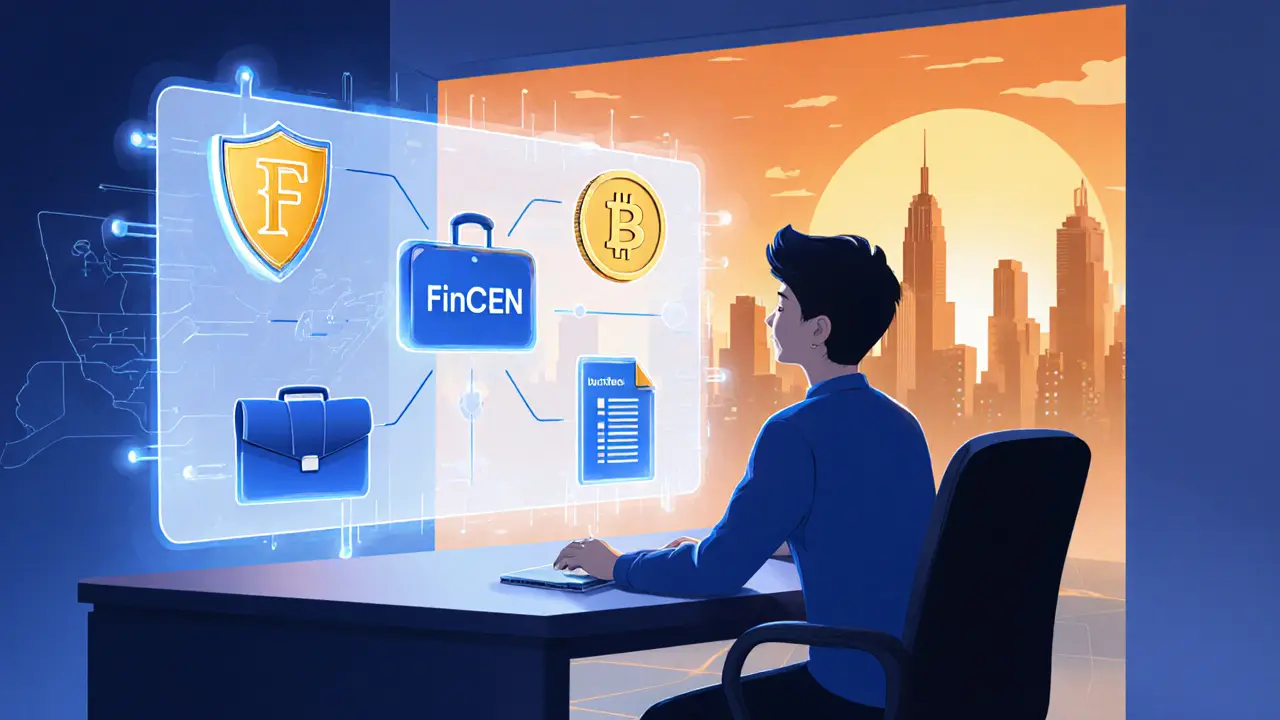Crypto Exchange License Pathway Planner
Required Licenses
Key Steps to Take
Estimated Timeline
Important Documents Needed
| Attribute | Money Service Business (MSB) | Money Transmitter License (MTL) |
|---|---|---|
| Primary Regulator | FinCEN (federal) | State financial regulator + FinCEN |
| Typical Services Covered | Crypto-to-crypto trading, wallet services | Any fiat-crypto conversion, remittance |
| Capital Requirement | $0 (but insurers often required) | $250k-$500k depending on state |
| Reporting Frequency | Quarterly SARs, annual BSA filing | Monthly/quarterly transaction reports |
| Typical Timeline | 30-60 days (FinCEN registration) | 90-180 days per state |
If you’re ready to launch a crypto trading platform, the first hurdle is getting a crypto exchange license. Without that approval you can’t legally accept deposits, match orders, or even open a bank account in most jurisdictions. Below is a practical roadmap that takes you from initial research to ongoing compliance, so you can focus on building liquidity instead of chasing paperwork.
Quick Summary
- Identify whether you need a Money Transmitter License (MTL) for fiat‑crypto swaps or a Money Service Business (MSB) registration for pure crypto‑to‑crypto trading.
- Register with FinCEN as an MSB - the federal baseline for all U.S. crypto businesses.
- Apply for state‑specific licenses (e.g., NY BitLicense, California MTL) based on where your customers reside.
- Prepare a detailed business plan, insurance coverage, KYC/AML program, and proof of $250k‑$500k financial backing.
- Maintain ongoing reporting, audits, and AML/CFT monitoring to keep the license active.
Understanding the Regulatory Landscape
Crypto Exchange License is a regulatory authorization that permits a business to operate a cryptocurrency trading platform legally within a specific jurisdiction. In the United States the framework is split between federal oversight and a patchwork of state requirements.
On the federal side, the Financial Crimes Enforcement Network (FinCEN the Treasury bureau that enforces anti‑money‑laundering rules for financial institutions) treats crypto exchanges as Money Service Businesses. That means you must register as an MSB, adopt a robust AML program, and file regular suspicious activity reports.
State regulators focus on consumer protection and solvency. Each state that wants you to operate there can demand its own license, ranging from a generic Money Transmitter License to a specialized BitLicense in NewYork. The Securities and Exchange Commission (SEC the agency that regulates securities offerings and trading platforms) and the Commodity Futures Trading Commission (CFTC the regulator overseeing commodities and derivatives markets) also get involved when your platform trades security tokens or futures contracts.
Pick the Right License Type for Your Business Model
Not every crypto platform needs every license. Start by mapping your service menu:
- Crypto‑to‑Fiat swaps - you’re moving money between digital assets and U.S. dollars. This triggers a Money Transmitter License (MTL) in most states.
- Crypto‑to‑Crypto exchange - you only match digital tokens. An MSB registration with FinCEN is usually sufficient, but some states still ask for an MTL.
- Security token trading - treated as securities, so you’ll need SEC registration and possibly FINRA membership.
- Derivatives or futures - falls under CFTC jurisdiction; you’ll need to register as a Futures Commission Merchant (FCM) and join the National Futures Association (NFA).
Below is a quick comparison of the two most common licenses.
| Attribute | Money Service Business (MSB) | Money Transmitter License (MTL) |
|---|---|---|
| Primary Regulator | FinCEN (federal) | State financial regulator + FinCEN |
| Typical Services Covered | Crypto‑to‑crypto trading, wallet services | Any fiat‑crypto conversion, remittance |
| Capital Requirement | $0 (but insurers often required) | $250k‑$500k depending on state |
| Reporting Frequency | Quarterly SARs, annual BSA filing | Monthly/quarterly transaction reports |
| Typical Timeline | 30‑60 days (FinCEN registration) | 90‑180 days per state |
State‑Specific Licenses You’ll Encounter
Even if you only need a federal MSB, most states where you have customers will ask for a local license. Here are the most common ones you’ll run into:
- BitLicense NewYork’s special cryptocurrency license that requires up to $500,000 in financial backing and strict AML controls
- California Money Transmitter License - mandates a minimum $250,000 budget and proof of insurance.
- Illinois exemption - individuals and entities dealing only with digital currencies can operate without a license, but you still need FinCEN registration.
- Texas - operates under a standard money transmitter framework, no crypto‑specific license.
Because licensing is state‑by‑state, a multi‑state launch often means filing separate applications, paying various fees, and keeping track of each regulator’s reporting calendar.

Gather the Required Documentation
Regulators love paperwork. Missing any of the following will delay your approval:
- Business Plan - include market analysis, revenue model, technology stack, and risk management.
- Founder Identification - government‑issued IDs, proof of address, and background checks.
- Insurance Policies - Errors‑and‑omissions (E&O) and cyber‑risk coverage are often mandatory.
- Financial Statements - demonstrate at least $250k‑$500k liquid capital, depending on the jurisdiction.
- KYC/AML Program - a written policy covering customer onboarding, transaction monitoring, sanctions screening, and SAR filing. This is where the AML/KYC Program a set of procedures to verify customer identity and detect suspicious activity becomes a living document, not a one‑time checklist.
- Banking Relationships - a letter of intent or actual account with a U.S. bank that accepts crypto‑related funds.
Having these items ready before you start the application will shave weeks off the timeline.
Step‑by‑Step Application Process
- FinCEN Registration - file the BSA‑5 form online, pay the $150 fee, and receive your MSB registration number.
- State License Research - list every state where you plan to serve customers, then map each to its required license (MTL, BitLicense, etc.).
- Prepare State Packages - replicate the core documents (business plan, AML policy, insurance) and tailor the financial backing proof to each state’s threshold.
- Submit Applications - most states use an online portal; upload PDFs, pay filing fees (typically $2,000‑$5,000), and schedule any required background interviews.
- Respond to Regulator Comments - be ready to clarify KYC procedures or provide additional financial statements. Speedy responses keep the clock moving.
- Obtain the License - once approved, you’ll receive a certificate and a license number. Record this in your compliance dashboard.
- Launch and Report - start onboarding users, then file the required SARs, transaction reports, and annual compliance attestations.
Typical timelines: FinCEN registration (1‑2weeks), state MTLs (3‑6months), BitLicense (6‑12months). Factor these into your go‑to‑market plan.
Ongoing Compliance - Keeping the License Alive
A license isn’t a set‑and‑forget badge. Regulators expect continuous monitoring:
- Monthly transaction monitoring reports to FinCEN and relevant state agencies.
- Quarterly AML program reviews - update sanction lists, refresh risk scoring models.
- Annual financial statements audited by a CPA approved by the state regulator.
- Periodic “know your business” (KYB) checks on corporate partners and custodians.
- Continuous staff training on AML/CFT best practices.
Failure to meet any of these obligations can result in fines, license suspension, or even revocation.
Offshore vs. Onshore - Where to Apply First?
If you’re not tied to the U.S. market, many offshore jurisdictions (e.g., Malta, Estonia, Cayman Islands) issue crypto licenses in under 60days with lower capital requirements. Those licenses can help you open bank accounts and attract investors, but they don’t replace the need for a U.S. license if you want American users.
Onshore U.S. licenses carry more credibility with banks and institutional investors, which can be a decisive competitive advantage. The trade‑off is cost, time, and higher compliance overhead.
Next Steps & Troubleshooting
Ready to start? Here’s a quick checklist you can copy‑paste into a spreadsheet:
- Define service scope (fiat‑crypto, crypto‑crypto, securities, derivatives).
- Choose primary license type (MSB vs. MTL).
- Register with FinCEN.
- List target states; note capital thresholds.
- Assemble business plan, insurance, KYC/AML policy, financial proof.
- Submit state applications; track deadlines.
- Set up compliance monitoring software.
- Plan for quarterly and annual reporting.
If an application gets rejected, the most common reasons are:
- Insufficient capital proof - double‑check bank statements and escrow letters.
- Weak AML policy - make sure you have automated transaction monitoring and SAR filing procedures.
- Missing founder background disclosures - provide full criminal‑record checks.
Address the regulator’s comments head‑on, resubmit within the stipulated window, and keep a detailed audit trail of all communications.

Frequently Asked Questions
Do I need a BitLicense to serve NewYork customers?
Yes. NewYork treats any crypto activity that touches a NewYork resident as a BitLicense‑eligible service. The application requires up to $500,000 in financial backing, a detailed AML program, and a thorough technology audit.
Can I operate with only a federal MSB registration?
You can trade crypto‑to‑crypto nationwide, but any state that requires a Money Transmitter License for fiat conversions will still block you. Most platforms launch with a federal MSB first, then add state licenses as they expand.
How long does the entire licensing process take?
FinCEN registration is usually 2‑3 weeks. State licenses range from 90 days (simpler MTLs) to 12 months (BitLicense). Plan for a 6‑month minimum runway before you can go live with full fiat support.
What insurance do regulators expect?
Most states require a $1‑2million Errors‑and‑Omissions policy and a separate cyber‑risk policy that covers digital asset theft. Provide the certificate of coverage with your application.
Is it cheaper to get an offshore license first?
Offshore licenses are faster and need less capital, but they won’t let you open U.S. bank accounts or serve American users without the corresponding U.S. licenses. Use them as a stepping stone if you’re targeting global markets first.


Ron Hunsberger
Great overview! The step‑by‑step layout makes it easy to see where the biggest bottlenecks appear, especially the capital requirement differences between MSBs and MTLs. I’d add that early engagement with a compliance consultancy can shave weeks off the state filing process. Also, double‑check the BSA‑5 filing fees, as they’ve risen slightly this year. Keeping the AML policy as a living document, not a static PDF, will keep regulators happy. Good luck to anyone diving into this maze – you’ve got a solid roadmap now.